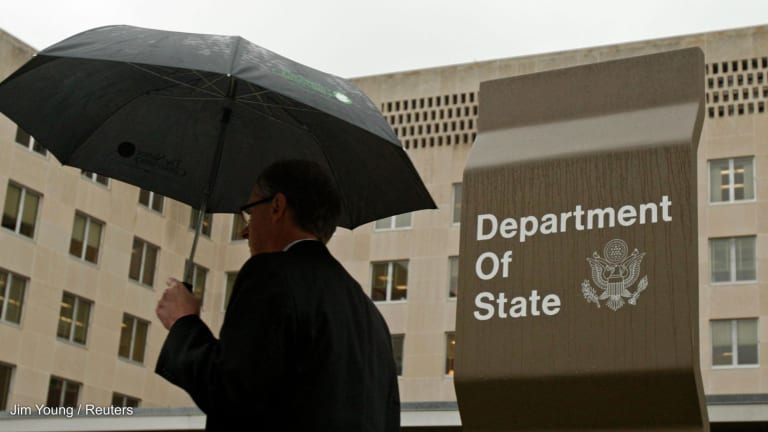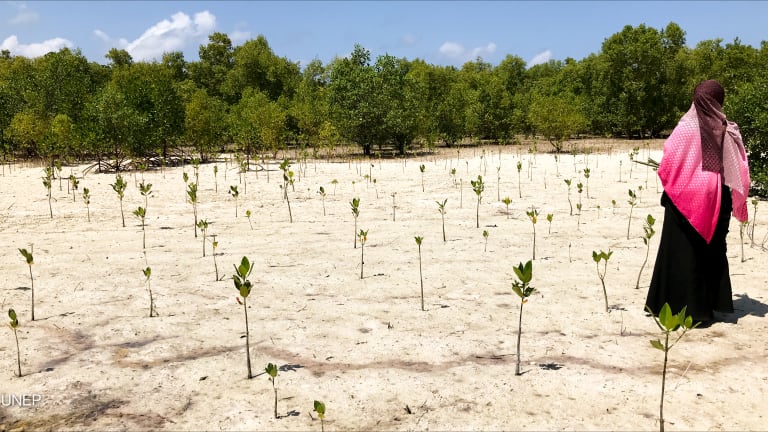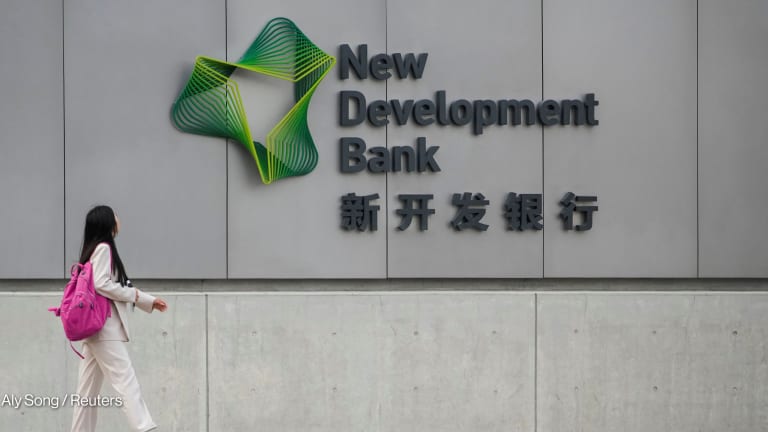How much did the US State Department spend on development?
About a third of the U.S. Department of State’s total obligation in a 10-year period went to development-related projects.
In March, U.S. Secretary of State Marco Rubio announced that all programs previously managed by USAID will be absorbed by the Department of State, or DoS. But how much experience and skill does DoS have in funding development? The U.S. is far from the first country to move its aid work into its foreign office. Other donors, such as Australia and Canada, have also gone through the same process. But what makes the U.S. different is how it did it so swiftly and with relatively little planning for how the transfer will affect existing projects. Prior to the dismantling of USAID, the Department of State’s role mainly revolved around ensuring that all development activities carried out by USAID and other U.S. government agencies align with the country’s foreign policy objectives. However the State Department also manages a considerable portion of U.S. aid, whether out of its budget or on behalf of USAID. Based on the Organisation for Economic Co-operation and Development, DoS accounted for about a fifth of total U.S. official development assistance, or ODA. But what exactly has it funded? What are its priorities, and which countries benefit the most from its assistance? We looked into the 2024 obligation data from foreignassistance.gov to find the answers. The top-level data The latest figures show that the State Department obligated a total of $18.6 billion in the fiscal year that ended in September 2024, of which $6.1 billion went to development. That’s a typical amount. In the preceding decade, DoS usually allocated around a third of its total obligation to development-related activities. Around 78% of the 2024 amount, worth $4.8 billion, came from the department’s own budget, while the remaining $1.3 billion was funded by USAID. Within DoS, the largest portion of aid came from the Bureau of Population, Refugees, and Migration, or PRM, worth $1.7 billion. PRM is responsible for reducing illegal migration, while also assisting displaced people globally. The Bureau of Global Health Security and Diplomacy, or GHSD, ranked next, with $904.8 million; followed by the Bureau of International Narcotics and Law Enforcement Affairs, or INL, with $762.9 million; the Bureau of Democracy, Human Rights, and Labor, or DRL, with $487.8 million; and the Bureau of International Organization Affairs, or IO, with $445.9 million. The remaining $1.8 billion was obligated by 19 other bureaus and offices. <div class='tableauPlaceholder' id='viz1746795041904' style='position: relative'><noscript><a href='#'><img alt='DoS offices and bureaus obligating aid ' src='https://public.tableau.com/static/images/Do/DoSofficesandbureausobligatingaid/DoSofficesandbureausobligatingaid/1_rss.png' style='border: none' /></a></noscript><object class='tableauViz' style='display:none;'><param name='host_url' value='https%3A%2F%2Fpublic.tableau.com%2F' /> <param name='embed_code_version' value='3' /> <param name='site_root' value='' /><param name='name' value='DoSofficesandbureausobligatingaid/DoSofficesandbureausobligatingaid' /><param name='tabs' value='no' /><param name='toolbar' value='yes' /><param name='static_image' value='https://public.tableau.com/static/images/Do/DoSofficesandbureausobligatingaid/DoSofficesandbureausobligatingaid/1.png' /> <param name='animate_transition' value='yes' /><param name='display_static_image' value='yes' /><param name='display_spinner' value='yes' /><param name='display_overlay' value='yes' /><param name='display_count' value='yes' /><param name='language' value='en-US' /><param name='filter' value='publish=yes' /><param name='device' value='desktop' /><param name='showShareOptions' value='false' /></object></div> <script type='text/javascript'> var divElement = document.getElementById('viz1746795041904'); var vizElement = divElement.getElementsByTagName('object')[0]; if ( divElement.offsetWidth > 800 ) { vizElement.style.width='590px';vizElement.style.height='427px';} else if ( divElement.offsetWidth > 500 ) { vizElement.style.width='590px';vizElement.style.height='427px';} else { vizElement.style.width='100%';vizElement.style.height='727px';} var scriptElement = document.createElement('script'); scriptElement.src = 'https://public.tableau.com/javascripts/api/viz_v1.js'; vizElement.parentNode.insertBefore(scriptElement, vizElement); </script> <i style=font-style: georgia;”>Top DoS offices and bureaus obligating aid in 2024, based on foreignassistance.gov</i> Which countries received the most aid? About 41% of DoS’ development aid in 2024, worth $2.5 billion, was obligated to multicountry and global projects, as well as funds and contributions to multilaterals. These activities are labeled as “World” in the dataset. Another $923.3 million went to development activities in South and Central Asia; $702.4 million to Latin America and the Caribbean; $677.3 million to Europe and Central Asia; $605.9 million to the Middle East and North Africa; $463.1 million to sub-Saharan Africa; and $265.7 million to East Asia and the Pacific. Among countries, the largest recipient was Ukraine, which received $504.2 million for 106 activities — about 8.2% of the total. Most of the relevant project information was withheld, but the largest one, worth $230 million, appears to be for a transportation infrastructure project. Colombia ranked next, with $148 million, most of which went to governance-related projects. Other top recipient countries were Mexico, with $67.6 million; Iraq, with $58.9 million; and Laos, with $48.3 million. <div class='tableauPlaceholder' id='viz1746794884944' style='position: relative'><noscript><a href='#'><img alt='DoS geographical distribution of aid ' src='https://public.tableau.com/static/images/Do/DoSgeographicaldistributionofaid/DoSgeographicaldistributionofaid/1_rss.png' style='border: none' /></a></noscript><object class='tableauViz' style='display:none;'><param name='host_url' value='https%3A%2F%2Fpublic.tableau.com%2F' /> <param name='embed_code_version' value='3' /> <param name='site_root' value='' /><param name='name' value='DoSgeographicaldistributionofaid/DoSgeographicaldistributionofaid' /><param name='tabs' value='no' /><param name='toolbar' value='yes' /><param name='static_image' value='https://public.tableau.com/static/images/Do/DoSgeographicaldistributionofaid/DoSgeographicaldistributionofaid/1.png' /> <param name='animate_transition' value='yes' /><param name='display_static_image' value='yes' /><param name='display_spinner' value='yes' /><param name='display_overlay' value='yes' /><param name='display_count' value='yes' /><param name='language' value='en-US' /><param name='device' value='desktop' /><param name='showShareOptions' value='false' /></object></div> <script type='text/javascript'> var divElement = document.getElementById('viz1746794884944'); var vizElement = divElement.getElementsByTagName('object')[0]; if ( divElement.offsetWidth > 800 ) { vizElement.style.width='590px';vizElement.style.height='477px';} else if ( divElement.offsetWidth > 500 ) { vizElement.style.width='590px';vizElement.style.height='477px';} else { vizElement.style.width='100%';vizElement.style.height='727px';} var scriptElement = document.createElement('script'); scriptElement.src = 'https://public.tableau.com/javascripts/api/viz_v1.js'; vizElement.parentNode.insertBefore(scriptElement, vizElement); </script> <i style=font-style: georgia;”>DoS geographical distribution of aid in 2024, based on foreignassistance.gov</i> Which sectors were prioritized? Based on the data, DoS funded over 20 sectors in 2024. More than a quarter of the State Department’s total development obligation, worth $1.6 billion, went to emergency response — mainly for delivery of goods and services and relief coordination. Most of the obligations to the emergency response sector were regional and multicountry, with DoS obligating $741.7 million to multicountry projects in South and Central Asia. But among those with specific recipient countries, Lebanon got the largest share, worth $19.1 million. Then Bangladesh, with $15.2 million; Turkey, with $14.1 million; and Mexico, with $13.7 million. The government and civil society sector ranked next among sectors, receiving $1 billion in obligations. About a third of this, worth $329.6 million, was obligated for democratic participation and civil society. Other priorities within the sector were human rights, with $291.2 million; countering extremism, with $110 million; and fighting transnational organized crimes, with $65.5 million. Somalia received the biggest obligation for country-specific projects in the government and civil society sector with $18.1 million, followed by Mexico with $15.7 million, and Ukraine with $11.9 million. HIV/AIDS was also among DoS’ priority sectors, with a total of $835.7 million obligations. All of this went to control of sexually transmitted infections. Virtually all of the obligations for HIV/AIDS went to regional and multicountry projects. Among country-specific activities, South Africa got the largest obligations, with $1.7 million; followed by Mozambique, with $1.5 million; and Zambia, with $1.4 million. <div class='tableauPlaceholder' id='viz1746795112307' style='position: relative'><noscript><a href='#'><img alt='DoS sectoral distribution of aid ' src='https://public.tableau.com/static/images/Do/DoSsectoraldistributionofaid/DoSsectoraldistributionofaid/1_rss.png' style='border: none' /></a></noscript><object class='tableauViz' style='display:none;'><param name='host_url' value='https%3A%2F%2Fpublic.tableau.com%2F' /> <param name='embed_code_version' value='3' /> <param name='site_root' value='' /><param name='name' value='DoSsectoraldistributionofaid/DoSsectoraldistributionofaid' /><param name='tabs' value='no' /><param name='toolbar' value='yes' /><param name='static_image' value='https://public.tableau.com/static/images/Do/DoSsectoraldistributionofaid/DoSsectoraldistributionofaid/1.png' /> <param name='animate_transition' value='yes' /><param name='display_static_image' value='yes' /><param name='display_spinner' value='yes' /><param name='display_overlay' value='yes' /><param name='display_count' value='yes' /><param name='language' value='en-US' /><param name='filter' value='publish=yes' /><param name='device' value='desktop' /><param name='showShareOptions' value='false' /></object></div> <script type='text/javascript'> var divElement = document.getElementById('viz1746795112307'); var vizElement = divElement.getElementsByTagName('object')[0]; if ( divElement.offsetWidth > 800 ) { vizElement.style.width='590px';vizElement.style.height='827px';} else if ( divElement.offsetWidth > 500 ) { vizElement.style.width='590px';vizElement.style.height='827px';} else { vizElement.style.width='100%';vizElement.style.height='727px';} var scriptElement = document.createElement('script'); scriptElement.src = 'https://public.tableau.com/javascripts/api/viz_v1.js'; vizElement.parentNode.insertBefore(scriptElement, vizElement); </script> <i style=font-style: georgia;”>DoS sectoral distribution of aid in 2024, based on foreignassistance.gov</i> Try out Devex Pro Funding today with a free five-day trial, and explore funding opportunities from over 850 sources in addition to our analysis and news content.
In March, U.S. Secretary of State Marco Rubio announced that all programs previously managed by USAID will be absorbed by the Department of State, or DoS. But how much experience and skill does DoS have in funding development?
The U.S. is far from the first country to move its aid work into its foreign office. Other donors, such as Australia and Canada, have also gone through the same process. But what makes the U.S. different is how it did it so swiftly and with relatively little planning for how the transfer will affect existing projects.
Prior to the dismantling of USAID, the Department of State’s role mainly revolved around ensuring that all development activities carried out by USAID and other U.S. government agencies align with the country’s foreign policy objectives.
This story is forDevex Promembers
Unlock this story now with a 15-day free trial of Devex Pro.
With a Devex Pro subscription you'll get access to deeper analysis and exclusive insights from our reporters and analysts.
Start my free trialRequest a group subscription Printing articles to share with others is a breach of our terms and conditions and copyright policy. Please use the sharing options on the left side of the article. Devex Pro members may share up to 10 articles per month using the Pro share tool ( ).
Miguel Tamonan is a Senior Development Analyst at Devex, where he analyzes data from public and private donors to produce content and special reports for Pro and Pro Funding readers. He has a bachelor’s degree in Political Science with a Major in International Relations from the Polytechnic University of the Philippines.








